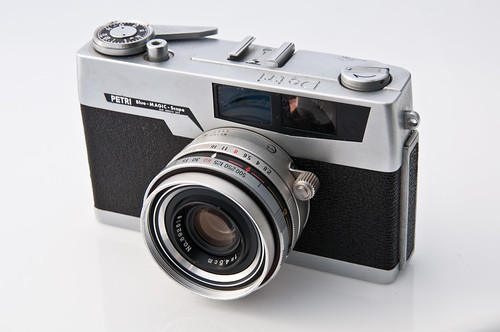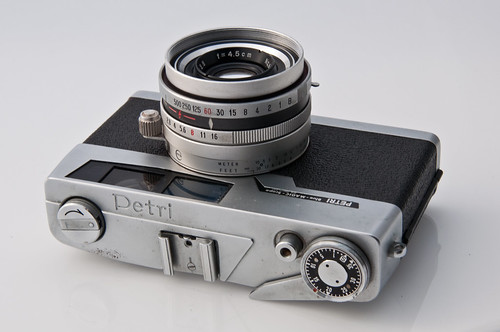Petri Touch

|
| Petri Touch image by Hans Jan Dürr (Image rights) |

|
| image by Hans Jan Dürr (Image rights) |
The Petri Touch, or Blue-Scope, is a fixed-lens 35mm rangefinder camera made circa 1961/1962. It is unclear where the name Touch comes from, as most cameras are labeled Blue-MAGIC-Scope (without the word "Touch") and the camera is referred to as the Blue-Scope on both the box and in the manual. However, in several photos in the manual for the Petri Blue-Scope the name "Touch" is clearly visible on the label of the camera, suggesting that this name may have been used on early versions or in some markets.[1][2]
The camera is a budget version of the Petri 7, being identical to that camera except it uses a blue-tinted rather than green-tinted glass over the rangefinder secondary window, does not include an integral light meter, and is limited to the f/2.8 lens only. The camera also includes a simplified version of the shutter, called the Petri V, which includes a self-timer but does not include an M-synchronization delay mechanism for flashbulbs. Consequently, the lens is labeled to show that flashbulbs can be used only at 1/30th second or slower shutter speeds, which is also indicated in the manual.
Early versions of this camera were produced during the year that the Petri 7 was produced, and include a Kuribayashi symbol embossed into the frame around the viewfinder. Later versions of the camera were produced after Kuribayashi officially changed its name to Petri; these versions include a Petri symbol embossed into the frame around the viewfiner. Production of the Petri Touch/Blue-Scope thus appears to have extended beyond the production of the Petri 7 it is based on, and overlapped with production of the Petri 7s. The Petri Touch/Blue-Scope is relatively rare compared to the Petri 7 or 7s.
The badge also carries the phrase 'color corrected super', like most Petri rangefinders since the Petri 35. The Petri Touch is found finished in either black or gray leatherette.
Its general specification is the same as that of the Petri 7:
- Coated 45mm f/2.8 lens
- Coupled rangefinder, combined in the same eyepiece as the viewfinder
- Brightline frame viewfinder
- Leaf shutter:
- Speeds from 1 to 1/500 second, plus 'B'
- Flash synchronised (X-synch only; flashbulbs accommodated through the slower shutter speeds)
- PC socket, and cold shoe on the top plate
- Lever-wind film advance with double-exposure prevention and a manual resetting frame-counter in the hub of the lever
Notes
- ↑ McKeown identifies the camera from the badge. McKeown, James M. and Joan C. McKeown's Price Guide to Antique and Classic Cameras, 12th Edition, 2005-2006. USA, Centennial Photo Service, 2004. ISBN 0-931838-40-1 (hardcover). ISBN 0-931838-41-X (softcover). p580.
- ↑ User's manual at Mike Butkus' Orphan Cameras.